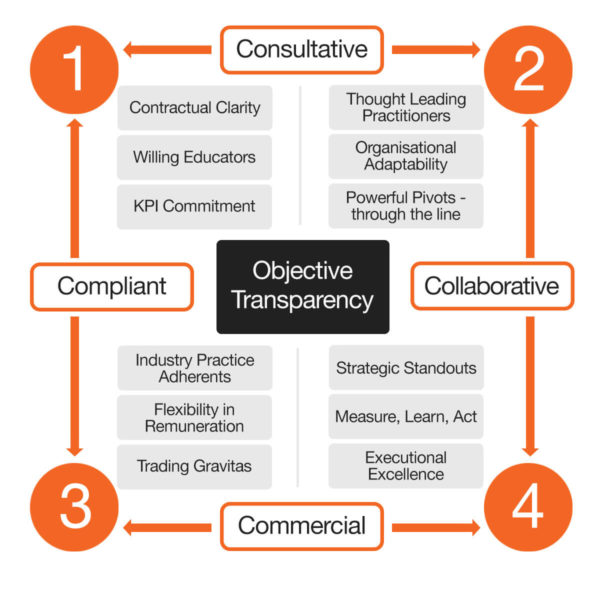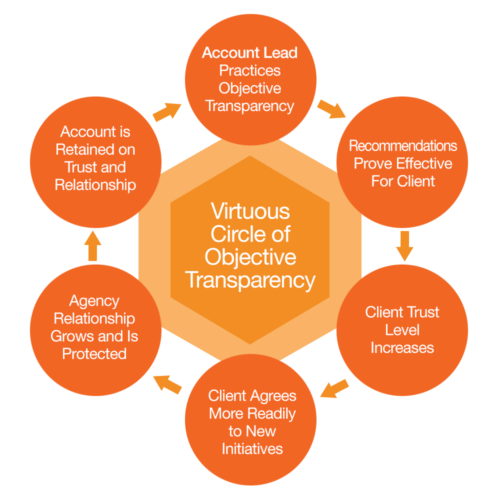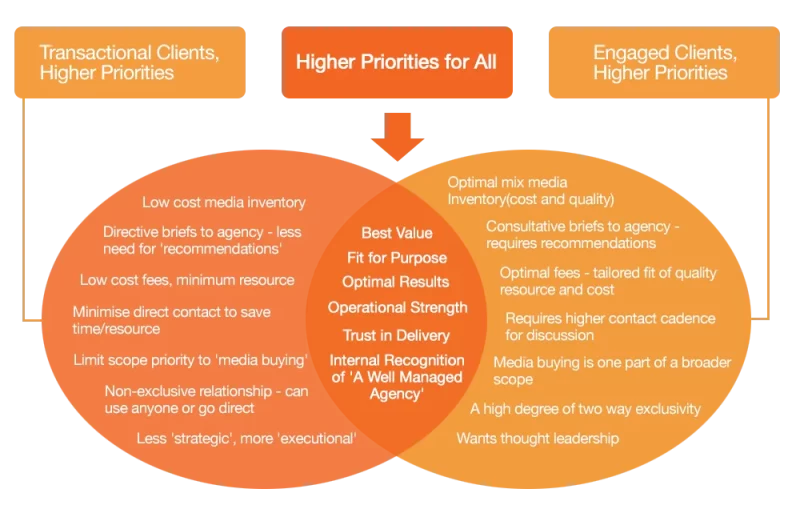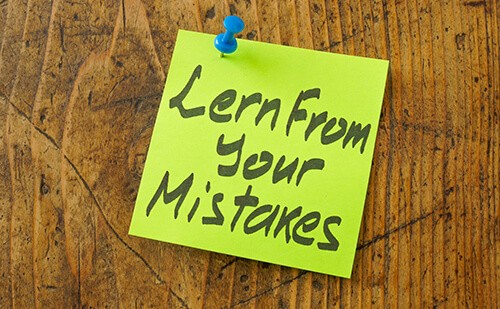
Introduction
Welcome to ‘Successful Client Leadership – A Guide for Agencies’.

If you’re reading this, it’s likely that you have an interest in learning about how to improve your client leadership skills, or those of your teams, or your agency as a whole.
Client leadership is a critical part of any agency operation.
Often, it is not given the same amount of attention as other functions such as digital expertise, trading, strategy, creative or new business development.
But the importance of client leadership should never be under-estimated.
Ultimately, we want this playbook to deliver both guidance and inspiration that will enable better client leadership within your agency.
The central premise of our belief is that better client leadership is critical to unlocking high performing client agency relationships.
Where high performing client-agency relationships exist, they are capable of delivering so much – happy and empowered teams, high trust, relationship longevity and commercial success.
And, of course, high performing agency-client relationships can also help to attract talent and deliver business growth via referral and case study.
However, the trajectory of our industry has not been kind.
An increasing downward pressure on resource, the development of a master-servant mentality in a race to the bottom culture and a shift in focus away from ‘account’ to vertical specialisms have all harmed the ability of both agency and advertiser to set themselves up for success in this way.
Client leadership on the agency side can be the turnkey to change.
This playbook aims to provide:
- Cornerstone definitions of ‘client leadership’ for the modern agency – advertising and media
- Rationale to show why a pivot to a leadership approach in agency account leads (as opposed to a service mentality) is critical to longer term agency success
- Actionable building blocks for agency leads – how should you and your people be thinking and what should your account leads be doing to take a leadership role?
- Actionable insights for account leads – how do you develop a client leadership focused operation on your account?
The most important outcome? The use of ideas and thoughts in building stronger client leadership traits, higher-performing relationships with your clients, and greater success across your agency.
High Performing Client-Agency Relationships: A Definition
We have just mentioned the central premise of ‘the high performing agency-advertiser relationship’. Let’s unpack this a bit further.
A high performing client-agency relationship:
- Takes time to build – it’s not something that can be placed into a contract
- Is based on largely intangible assets that deliver tangible results
- Is dependent on people and on integrity, above all
- Should not be financially incentivized in and of itself (the tangible results are what should be)
- Requires leadership, emotional investment and bravery from both client and agency
- Requires a cultural mindset within both client and agency organizations – agreed with and adhered to
- Is not dependent on feel-good incentives or clunky social interactions to survive or thrive
- Is single minded in intent
- Does not exist in silos, or with walls – it is based on shared information and honest interaction
- Can survive hard conversations in pursuit of excellence.
- Has no ego and has mutual, genuine respect for the contribution and skillset of both parties
- Succeeds and fails together, and recognizes that failure can happen as long as learnings are gathered and applied
- Sets ambitious goals and makes them part of the vernacular
- Is tailored to fit, rather than off the peg
- Never stands still, always learns and continuously tries to evolve
- Is transparent in all regards, on both sides
Take a look through this list and ask yourself: how many agency-client relationships does your agency have that tick even some of these boxes?
It’s likely that, hand on heart, the answer would be a minority at best. And this is why we have produced this white paper.
We believe that a greater number of high performing agency- client relationships could a significant contribution to positive change in our indus
try, across a range of macro-challenges recognized for some time.
Changes such as:
- An increase in industry morale, well-being and sense of purpose
- A move towards fairer agency compensation and a reduction in unhealthy procurement tactics
- Modernization of the way in which agencies are targeted
- Increased impact of the agency, of any discipline, in moving commercial dials
- Higher creativity and innovation (stemming from bravery)
- Better industry reputation, attracting higher-calibre talent
On the agency side, we believe that there is no better turnkey to achieving high performing client-agency relationships than the development of a client leadership mentality. You’ll see echoes of this chapter running through the rest of the document.
A Guide to Client Leadership in Agencies
Part 1: Guidance for the Agency Lead
How Are We Defining ‘Client Leadership’?
The term ‘client leadership’ is used deliberately throughout this playbook, to differentiate it from ‘client service’.

Client service (which we could also call ‘account management’) is, of course, critical. Without strong day to day operations, the whole account falls down.
Client service represents the stable base; client leadership is what can make your relationship stronger, more developed, strategically driven and more successful over time.
The agency team that has either a strong client leader overseeing an account lead, or an account lead that develops a client leadership approach, is an agency team with real competitive edge in the market.
And, whilst there is no failsafe way to stop an account loss or pitch, the agency team with strong client leadership will have given itself greater protection against these outcomes.
Let’s take a look at the differences between client leadership and client service. The table below profiles two account leads. Joseph is a perfectly good account lead, operating with a ‘client service’ approach. Josephine, on the other hand, is an account lead operating with a ‘client leadership’ approach.
| Joseph: An Account Lead with a ‘Client Service’ Approach | Josephine: An Account Lead with a ‘Client Leadership’ Approach |
| Proactively manages key client relationships, gaining client trust in ability to deliver successful operations | Builds close, consultative relationships with key stakeholders, gaining client trust in ability to provide thought leadership and advice, both personal and professional |
| Has strong capability to present convincing work to the marketing leaders and team | Has strong capability to present convincing work to multiple client functions, including CEO and CFO, and is called into the boardroom by the client |
| Is focused primarily on day to day and current planning cycle | Is focused on the now, the next and the later – strategically on building into the future |
| Has deep knowledge of the operations of client organization, competitors and category | Has deep knowledge of the business and commercial objectives, barriers and challenges of client organization, and the client/s as individual/s |
| Is viewed by the client as a service provider/supplier | Is viewed by the client as not just a service provider, but as business partner/trusted advisor |
| Is reactive to what is being asked in a brief | Works with the client to build out what needs to be done, or has capacity to challenge what is being asked as required |
| Impresses the client with the work | Impresses the client with the work, and influences the client with counsel |
| Is seen as the go-to for anything related to discipline | Is seen as the go-to for anything related to discipline, in addition to a broader role as part of an executive leadership team |
| Internally leads and manages the agency team and the direct output of that team | Internally leads not just the output but the commercial growth of the agency – owns the account P&L and pivots between objective assessment of client needs and understanding of growth opportunities for the agency to build coherent business plans. |
| Manages the expectations of internal agency stakeholders by driving agency targets or preferred outcomes to the client | Manages the expectations of internal agency stakeholders by influencing, guiding and standing ground where necessary to ensure objectivity, whilst considering tailored to client approaches that can deliver both client and agency results in different ways |
| Is aware of what the agency charges in broad terms, and the correct way to apply those charges on plans and financial reconciliations | Understands in depth the contract, SOW and associated nuances, and uses the contract as one of the pillars on which to build the relationship and an ongoing, sustainable business plan. |
The differences here are in nuances of approach. It is not that ‘one is good, one is bad’. It is about the fine lines between good and great. Adopting the leadership approach gives competitive edge to the agency, and better outcomes to the client.
Ultimately, Joseph is a good, strong account lead. Josephine, on the other hand, is great.
Over time, Joseph will establish trust, and Josephine will become a trusted advisor.
Joseph will work hard to maintain the status quo between agency and client. Josephine will work to shape the agency around the client, to mutual benefit.
Joseph will deliver entirely satisfactory outputs to his client. Josephine has a greater chance of delivering truly value-driving outcomes.
Joseph will successfully deliver across the life of a relationship. But Josephine is more likely to retain her client when the account comes up for review; she is also more likely to prevent a review from happening.
With these definitions in mind, take a look at the majority of relationships your team leaders have with their clients. What are the dynamics of those relationships? Do they fit more into ‘client service’ or ‘client leadership’?
If the answer is predominantly ‘client service’, and you’re interested in evolving your agency to give it a competitive edge, you need to take steps to ensure that you or your teams evolve to a client leadership model, over time.
Why does Your Agency Need to Pivot to Client Leadership?

This has created the paradox of clients moving away from agencies, or taking a more dictatorial role with their agencies, at a time when the consultative advice of a strong agency is needed like never before.
In short, the agency-client relationship dynamic has never been more weighted in favour of the client.
Agencies have been squeezed so hard on fees and commercial terms that maintaining profitability, keeping clients and feeding the new business machine are all significantly bigger challenges than they were in the past.
For example, TrinityP3 research in the creative agency sector showed that like-for-like remuneration for agency services has declined by 2/3rds in the past 30 years.
The multifarious consequences include agency industry talent drain; teams that are lean, stretched, more junior and dealing with a larger set of client and other-agency stakeholders; reduction in quality of output; opaque fee structures and commercial practices.
Clients dictate Scopes of Work, agency staffing plans and the cost of agency FTEs, and allocate Scope of Work deliverables among roster agencies.
Most pertinent to this discussion, today’s environment is naturally geared towards agencies taking a ‘client service’ approach – which we define here as ‘doing what the client wants, in the agency’s best interests’. In the longer term, this approach benefits no-one.
In taking this approach, the role of the account lead has been diluted and overshadowed in agencies. Many agencies actively dissuade a leadership approach. Or, they have not set up the infrastructure to build a leadership approach into their key account people.
TrinityP3 research identifies a number of critical gaps in agency culture and structure, inhibiting true client leadership from developing in many agencies.
- There is no “Agency Way” to manage client relationships — no templates or best practices to serve as guides for account leads. There is no ideal “Agency Way” to document Scopes of Work or to price agency services. In this respect, agencies are extremely different from consulting firms, who take great pride in training their client-facing consultants in “The Bain Way” or “The McKinsey Way” — assuring a high level of uniformity in practices throughout their networks of offices and assuring that client-facing consultants can be proactive in ways that they have been taught.
- The lack of uniformity and training for account leads at creative agencies assures that there is excessive variability in their practices and outcomes. Within a given agency office of 10 major clients, our research shows the following:
- Pricing of agency work. The difference between the “best paying client” and the “worst paying client” for a uniform mix of SOW deliverables is 4 to 1. Since SOW workloads are not measured or used in fee negotiations by most account leads, there is a huge range in “price per deliverable” achieved (on an apples-to-apples basis for the type of deliverables in the SOWs).
- Output per creative FTE. The creative output per creative FTE per year between the “best paying client” and the “worst paying client’ for a uniform mix of SOW deliverables is 4 to 1. Low paying clients are always understaffed for SOWs, and creatives have to stretch to deliver the required SOW outputs in a timely manner.
- Mix of clients in an office. Underpaying clients (relative to SOW workloads) usually account for 65% of the workload in an office but only 45% of the fees, whereas premium paying clients account for 35% of the workload but 55% of the fees. However, premium paying clients are slowly disappearing from the client mix, and underpaying clients are becoming the norm. Overall, the average client in the office is an underpaying client. Clearly, there are chronic differences in the way account leads operate and negotiate. There are “best practice” ways that need to be identified, codified, and used routinely for training and accountability purposes.
Creating the Right Environment for Client Leadership to Thrive
Client leadership won’t happen in your agency, without a culture and set of practices that enables it.

This approach amounts to an agency culture that either actively drives or passively allows a client service mentality to drive its account leads, rather than a client leadership mentality.
Let’s put an example on the table.
How about the media agency with an internal target of securing a level of dollar expenditure within its own trading desk or DSP, rather than anywhere else – or insisting on a share of spend within a particular media publisher in any channel, to honour an agency-wide trading deal.
An account lead with a leadership approach, acting in the interest of the client, would possibly suggest a pro-active vendor test to establish best results, before making an agnostic decision about where to place those dollars. She would have an internal conversation to explain the position of the client, and maybe frame a further discussion around ways to achieve broader agency targets across other clients.
This person is acting in the best interest of the agency in that she is providing a truly consultative approach that will help retain the client longer term. She’s also acting in the best interest of the client, for obvious reasons.
An account lead with a service approach would direct the dollars into the channels required of him by his agency and then, in an attempt to ensure client satisfaction, present great results of the campaign to the client.
The results would not necessarily be ‘fake’ and the client may be happy. But of course, the question of ‘could we do even better with a different vendor mix’ is left unanswered by default. Only if the client demanded it would this person run a vendor test. Furthermore, in any subsequent pitch, the agency is far less able to defend the inevitable competitive claims or promises of better performance.
Here’s another example. How about the advertising agency who wants to increase its scope, revenue and profitability by introducing new services – say, a new consumer research tool.
An account lead with a leadership approach would bring this product to the client table and have a balanced discussion about it, before making a recommendation either way based on the response of the client. The account lead with a service approach would be trying harder to force-fit the solution in via hard sell or convoluted benefit claims.
Agencies, of course, have to make money and they have to retain clients. The expansion of remit within existing clients, or the structuring of deals to ensure cheapest possible media inventory so that the client pays less, are two legitimate ways of doing this.
But the approach of the account lead in delivery has critical implications for how the agency is viewed by its client, longer term (and particularly if the account is put to pitch).
It follows that the role of the agency, culturally, structurally, in training and development and in general intent, dictates the approach of its account leads.
The agency that literally forbids its account lead to even suggest that media vendor test, or the agency who simply doesn’t care about anything other than feeding the new business pipeline, is not the agency where a client leadership approach is going to thrive.
At the same time, the willingness of the client to pay properly for the experience required in a true account ‘leader’ is also vital – as is their own culture in welcoming in and working with this person to best effect.
The problem is that none of these building blocks are the norm. There are many consequences, one being a talent hole. In our industry, there are too few account heads operating with a true client leadership approach.
The First Step – Conduct an Agency Wide Practice Audit
Fully understanding the current status within your agency – commercially and culturally – is fundamental.
- Develop the information and data to understand the Pricing, Resourcing and Scope of Work situations that exist across your clients. Do this as a pilot exercise that can be duplicated elsewhere.
- Conduct an in depth operations assessment across a small number of selected accounts – including stakeholder interviews with both your own team and the client team – to understand:
- Account operations and processes
- Account SWOT
- The approach of your account lead
- The quality of outputs
- The status of the agency business plan for each account
- The client-agency relationship dynamic.
- Use the information and data from steps 1 and 2 to characterize the problems and opportunities that exist in the office — and, most likely, on a wider scale. If there is uncertainty about this, conduct a second pilot in a second office.
- Develop an action plan that includes a cultural or operational reset (if appropriate) in addition to training, mentoring, systems development, metrics, ongoing accountability reviews and other actions designed to create and reinforce an Agency Way of managing commercial, cultural and operational practice with key clients, grounded in a leadership mentality.
The Second Step – Develop a Client Leadership Culture
In tandem with understanding status via a Practice Audit and the necessary resultant actions, consideration needs to be given to a Client Leadership Blueprint – a single source of truth defining what Client Leadership is within your agency.
This necessarily needs to be tailored to your individual agency language and style. It can form the base on which your Action Plan is grounded.
To provide understanding of what it could look like, TrinityP3 has constructed a Client Leadership Blueprint called ‘The 4 C’s.
The 4C Blueprint
No two clients are identical. However, a 4C model of client leadership can be developed and adapted to fit your client requirements.
The 4 C’s

Consultative
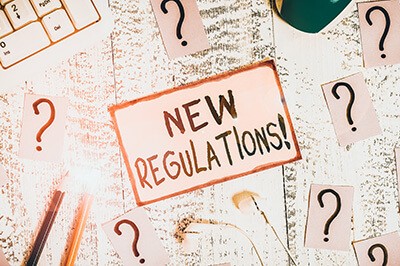
Compliant

Commercial

Collaborative
Consultative. To the client, the agency account lead is a thought leader, an educator, a confidant, a challenger and a sounding board. If there’s a problem that needs solving, they are the first person the client calls. They are leading a group of people who have the right expertise through the line, in addition to a strong balance of focus between the reality of now and the possibility of the future.
Compliant. The account lead’s working cadence or operational working arrangement with the client has the right level of structure, clarity and flexibility. They are willing to stand up and be counted against their performance and the contribution made to their client’s business. They effectively manage, lead and guide internally across multiple agency functions. More than this, they are prepared to be a part of driving best practice in the industry.
Commercial. The account lead can handle strategic and commercial discussions at high level. They develop media or communications strategies to influence business outcomes. With vendors, they trade with the right balance of confidence, assertive power and knowledge. Their team is following their vision and can get the job done when the rubber hits the road. Equally, the focus of the account lead in commercial agreements with the client is driven by value, not just by cost, and they make no apologies for the agency being in business itself.
Collaborative. The account lead and their team are adaptable enough to thread through the client’s organisation across multiple touchpoints, including other rostered agency partners, with the appropriate amount of grace, care and conviction. Ultimately, leading to an integrated strategic approach and great execution as a joint team. At the same time, they’re able to explain with clarity and conviction their own agency’s model and adapt as appropriate to fit needs.
The 4 C’s are not mutually exclusive. If we think about how the 4 C’s can be applied to agency operations, we get the following table, split into four quadrants.
Willing Educators, KPI Commitment and Contractual Clarity.
Willing Educators. As a subject matter expert, and with a group of subject matter experts in a team, there’s so much about which the agency can ‘educate’ its client.

KPI Commitment. It’s easy to agree KPIs up front and then either forget about them or fail to properly implement them.
The account lead needs to build and adhere to a simple, strong set of KPIs. Linked to flexibility in remuneration, they should be prepared to put a financial stake against performance as an agency, to mutual benefit.
Contractual Clarity. The account lead should work internally and externally to help deliver a mutually beneficial yet transparent contract with the client.
They should also be comfortable and knowledgeable about how transparent the agency is prepared to be.
It is also important to ensure that contracts get regularly reviewed. The willingness of the account lead to modernize or alter the contract with the client as necessary can be a great lever to help preserve a relationship without pitch.
Thought Leading Practitioners, Organisational Adaptability, and Powerful Pivots.
Thought Leading Practitioners. It’s not just about the CEO writing opinion pieces. The account lead should be active in the industry and encourage all functional leads across areas such as creative strategy, trading, implementation, digital, data, or production to be sufficiently plugged in to the market, so that they’re able to lead client teams, where necessary.
Thought leadership does not just apply to new and emerging areas of agency practice. The account lead should show the client that they recognise the value of maintaining strong skillsets in traditional areas, and are therefore balancing the now, the next and the later without detriment to effectiveness.
Organisational Adaptability. The account lead should be willing and able to mould around the client’s needs, rather than the client moulding around the agency.

This does not mean abandoning agency identity or an agency way of working. It means ensuring the operation is driven in ways meaningful to the client. And, critically, that it is communicated with clarity and in a timely manner.
Agency recognition that progressive marketing, and the sell-in of new marketing concepts do not begin and end with its own strategic wheel can be great for clients to work with.
This understanding and how it is taken into the agency, and then reflected in the output of the agency team, starts with the account lead.
The clichéd notion of the agency as extension of the marketing team is still relevant.
Powerful Pivots. The skill of account leadership is not always as apparent as those demonstrated by the functional leads, yet it is crucial to you, now more so than ever.
The account lead acts as a pivot between different functions internally, between those functions and different points of a marketing team, and between the agency and other suppliers. Furthermore, the account lead needs both the gravitas and the internal mandate to be able to lead the account across functions (considering that there are often no direct cross-functional reporting lines to an account lead).
The account lead needs to be able to ‘loosen the tie’ with the client, to talk on a level about challenges and how to solve them and be prepared to stand up and be counted when things go wrong, rather than trotting out the corporate lines.
The account lead needs high empathy, strong integrity, and they need to be able to play within the right boundaries as well as flex them where possible or where necessary. They need to have enough gravitas to sit with a client’s senior team in a consultative capacity.
Ultimately, the account lead should be seen by the client as someone who has their back; and, who can stand with them in the organisation, rather than just standing in front of them.
Everything described in this section naturally take time to develop, but in terms of unlocking agency potential it can make a fundamental difference to overall performance.
Industry Practice Adherents, Flexibility in Remuneration and Trading Gravitas.
Industry Practice Adherents. At the senior level, representation and compliance with industry bodies is important for obvious reasons; across functional departments, and the account lead should be able to demonstrate integrity and diligence in practice.

The systems, technology and tools the agency uses – and showing their use in ‘real life’, not just in the pitch – are also a sign of strong adherence to best practice.
Flexibility in Remuneration. The increased involvement of procurement in the agency selection and contractual process has given rise to a greater focus on remuneration structures.
If agencies are really trying to adapt themselves, they need to consider remuneration structure and how it contributes to building a sustainable and mutually beneficial partnership between agency and client.
The account lead is in a strong position to assess this and in advance of a review process, they should be considering new options or alternatives that will better fit with the evolving relationship and communicating this internally with agency leadership.
They should also be open and willing to work with the client in discussing performance-based incentive structures that will help to establish a business partner mentality; but assertive enough not to simply accept the client’s proposal, if that proposal is fundamentally unsound from an agency perspective.
Trading Gravitas. The account lead should be willing and able to offer a degree of reassurance to the client regarding the transparency of your trading operations (this could be media inventory trading, it could be the production quote/procurement process, or any other area where the agency acts on the clients behalf with third party vendors). The account lead should also be willing to include the client in dialogue or negotiation with third party vendors where appropriate.
Strategic Standouts, Executional Excellence, and Measure, Learn, Act
Strategic Standouts. The best agencies, when given the opportunity, think about strategy commercially and pragmatically, not just in terms of big ideas or award winners; they think about strategy collaboratively, from the perspective of ensuring that their approach gels with an overall position or with the work of another agency; and they think about strategy creatively, wiring it in to consumer insight.
The account lead should pro-actively champion this approach internally and with the client, and it should extend through media or comms strategy into to the creative process, channel planning (paid, owned and earned) that supports the strategic proposition.
Executional Excellence. Execution represents ‘nine tenths of the law’. Without strong attention to the detail of execution, everything else falls away.

Measure, Learn, Act. When it comes to measurement, the account lead should want to work with client and team to get under the skin of campaign performance – and learn from it collectively, working to continuously improve performance. Campaign measurement should not be an exercise in validation for the agency; it should shine a light of truth on what worked and what didn’t. The account lead should champion this approach.
Acting on learnings to evolve should be a continuous process, always explored and followed through, led by the account lead.
Summary
It may be daunting to consider the kind of shift required to achieve a Client Leadership culture within your agency or office. Some aspects of what we describe here may seem counter-intuitive.
However, the best agencies out there are working with these kinds of individuals to create lasting, pivotal and productive relationships with their clients.
If we as an industry want to return to more agencies being properly compensated for the work they do, staffed to the right levels and able to do brilliant work, TrinityP3 believes that the role of the account lead, and the adoption of a culture and approach that allows them to thrive in leadership and not service, is critical to success over the medium to longer term.
A Guide to Client Leadership in Agencies
Part 2: Guidance for the Account Lead
The Essence of Client Leadership
When you’re an account lead, you need to wear more than one hat – you need to be objective when considering two things:
- The needs of your agency as a business – growth opportunities, revenue, people, client retention.
and - The needs of your client as a business – what recommendation is going to work best for them?

A degree of internal resistance to agency opportunities that may not actually be right for your client is required.
However, you must be able to replace such opportunities with other, appropriate initiatives that are right for your client, but will also fulfil internal financial objectives.
It is very important that the interests of your agency are protected. You do not want to be viewed internally as ‘working for the client, more than for the agency’.
For example, your agency may be pushing you internally to recommend specific media vendors (TV channels, DSP’s, magazine groups or similar) in order to reap higher rebate rewards, or to fulfil trading obligations.
If these vendors are not right for your client, there are a number of steps to consider:
- Setting up a test to determine best selection and gain proof points regarding which vendor should be used
- Ensuring that in up-front planning, you make internally clear the appropriate choices for your client, so that any deals may be adjusted accordingly
- Considering other ways to drive revenue that may be more appropriate for your client, or building alternative deals
Another example could be a situation where your agency is pushing you to sell in new agency products that you know are not right for your client at the current time. In this case:
- Talk to your agency leads about ‘if not now, then when’ your client may be ready for this product, and why
- Think about how this product may be built into longer term business plan
- Talk to your agency about other products that your client could benefit from right now and focus on those
- Set up a sharing session with your client that isn’t ‘hard sell’ but enables you to both communicate new offerings and sensibly gain feedback and/or alternative ideas
The sweet spot is to build a ‘virtuous circle’ of objective transparency that helps both parties to grow.
What is Client Leadership NOT About?
Many people in agencies who become account started in a functional role – trading, strategy, administration or similar.
It is often tempting to gravitate back to the comfort zone of where you have come from. But it is critical to understand that as an account lead, you need to develop a more rounded perspective. It is also important to consider that you are now a conductor – you are no longer in the orchestra.
Client Leadership is NOT about the following:
- Producing the outputs. You have a team of experts for this. It is your job to ensure that the right experts are engaged in the right way, at the right time. And – while you don’t produce the outputs yourself – you remain responsible for them.
- Answering every question personally. Ditto the above – you have a team of experts. You need to be able to converse on many topics, but development of detailed answers resides with the functional experts in your team and sometimes beyond.
- Being a single-subject matter expert. You’re always going to have some things you know more about than others. But as an account lead, you need to build an understanding of how everything works together and be able to converse at this level.
- Being a bag-carrier. The days of ‘the empty suit’ – the account lead who is simply responsible for making the client feel good, ensuring that the coffees are warm and the client entertainments go off with a bang, are long gone. As account lead you are the central point between client and agency teams, a two-way (sometimes more than two-way) intersection conveying information and advice.
Not All Clients are Born Equal: The Importance of Tailoring in Client Leadership
A strong client leadership approach can help to overcome numerous threats to agency relationships. But no two clients are identical.
Think about the commonalities between what different types of clients want or need, and the need for client leadership, rather than just client service, can immediately be seen.
Different types of clients have the same essential needs.
The diagram below demonstrates these commonalities based on two simple ‘client types’ in a media agency (of course, a similar diagram could be built for an advertising agency):
- ‘Transactional Clients’ – less driven by relationship, views media agency as a supplier
- ‘Engaged Clients’ – more driven by relationship, views media agency as a partner
The definition of each common priority may differ – for example, ‘best value’ is different for a transactional client than it is for an engaged client.
But the commonalities remain. The client leader needs to be in tune with this, from one client to another.
What’s more, a client-agency relationship should be treated as a living thing – continuously evolving and reacting to circumstance. It is all too easy to fall into a swim-lane at the start of a relationship and never change direction, which leaves your agency open to any competitor who decides to knock at your client’s door with something ‘bright, shiny and new’.
It follows that ‘client leadership’ therefore means different things, to different types of clients. And it is generally something that is often in flux, rather than fixed – you need to be a shape-shifter.
Adopting a Client Leadership Mentality

These are questions that are easy to dismiss with ‘of course I know!’ – but which are all too often not given enough weight.
Be honest with yourself and ask – how up to date is my understanding?
-
- Communication Cadence and Approach. Do you know how this client actually likes to be communicated with? And how your client needs to communicate internally? Language, tone, format/medium, directness, frequency?
- Frustration and Approval Signals. Do you know how your client expresses frustration or approval? Can your team read these signals?
- Acceptance of the Status Quo. Are you and/or your client doing things a certain way ‘because it’s the way things have always been done’? How long is it since you have really considered changing things up?
- Understanding the Client Business. Are you and your team up to speed with your client’s business? Do you receive enough information from your client for this to be possible? What should you be asking for?
- Understanding the Scope. How long is it since you have looked at the scope that was actually agreed at time of contract signing? How different is that scope from what you are actually doing?
- Understanding the Contract. Do you have clear understanding of contractual period, renewal triggers, bonus payments or at-risk components, and other obligations?
- Team Relationship Dynamics. Do you know who your client views as stronger or weaker in your own team, and why?
- Output Fit. Have you seriously considered how much of the work you do is actually used by the client, and how much represents box-ticking or wheel-spinning?
- Output Quality. Is the quality of your team’s output strong enough for this client?
- Understanding Your People. Do you have the right people on your team? Are any of them burnt out? Are any of them de-motivated or itching for change?
- Understanding Your Internal Leadership. Are you and your own leaders aligned with regard to what the ambitions are for this client, and what you need to succeed? Do you have the internal mandate to lead the account effectively?
- Client Organization Status. How up to speed are you with changes in your client’s organization that may result in change? For example, commercial pressures, a new CEO, new systems or processes. And have you actually addressed them with your client?
- Client Team Needs. Have you recently asked about the needs of your client’s team? What can you be doing to make them shine, and work better with your team?
The answers to these kinds of questions may be simple, or they may be complicated. They may require a lot of work, or none at all. The point is: you’re asking them, either internally or directly with your client. And by doing so, you’re attempting to adapt.
Steps to building a Strong Client Leadership Model
“Any given marketing program is only going to be successful if all partners involved have a strong depth of understanding of the business strategy… It might sound simple, but truly knowing the business challenge… TRULY knowing it, will be the foundations of success. And you can only get to that point with a relationship that is rock solid, and completely transparent… there should be no secrets. If you can honestly say you have that relationship, you’re half way there.”
CMO, B&FS Category
So far, we’ve talked about what you ‘should’ be doing as an account lead with a client leadership approach and mentality.
But how do you take practical steps to achieve this kind of relationship both internally, and with your client?
1. Initiate an Operations Review
An Operations Review is an in-depth assessment of all operational aspects of the relationship – working both ways, to consider both client and agency.
Sometimes, with large or complex clients, it may be better to hire an external consultant to perform an Operations Review. In which case, you may be able to go to your client and suggest it pro-actively, with a cost-share agreement.

For clients that you believe should not be approached in this way (for example, if the relationship is not strong enough to withstand any negative outcomes, or if it would prove too de-stabilizing), the option is to run a purely internal review, which will also deliver some great insights.
Assuming that a full two-way approach is appropriate, the objectives of an Operations Review are:
- Generate intricate and unbiased understanding of current performance on both sides
- Identify strengths and challenges, such as any perception gaps or specific frustrations
- Align on commitment to changes where necessary
- Build a concrete action plan/development roadmap
- Create knowledge building blocks for an Internal Business Plan
Structuring an Operations Review
Although an Operations Review can generally be tailored to fit circumstances, there are a number of elements that would typically be included, highlighted in the table below.
- Stakeholder Interviews. Face to face, individual interviews with both client teams and agency team, held under condition of anonymity.
- TRR Scoring Process. Client version and agency version, providing marks out of 10 against a number of weighted criteria.
- Perception Gap Mapping. Using Stakeholder Interview inputs and TRR scores, identify similarities and differences in perceptions of client and agency team (for example – the agency sees itself as very pro-active; the client views the agency as not pro-active at all).
- Contract and Scope Review. Re-visit the contract and scope of work and assess what can remain and what needs to change.
- Business Assessment. Current SWOT of your client’s business, identification of key growth initiatives, SWOT of your relationship with your client and identified objectives
- Output Assessment. Assessment of client briefs, and work outputs, over a pre-defined period, to identify areas of strength and weakness.
- Findings Report & Action Plan. A small, senior level group sees a presentation of findings and recommendations and agrees an action plan.
- Group Communication. Positive communication from the leadership team to the broader group, with shared Action Plan.
- Operational Summary. An operational summary is a shared document for agency and client team. It should be easy to follow and concise. An operational summary is an agreed overview of how the account is going to be run, day to day – key meetings/contact points, approach to briefing, regular tasks and reports, sign off process, etc. – with roles and responsibilities for both parties. The point of this document is to have a recording of the agreements made in the review process, easily accessible outside of the contract, that helps to avoid confusion or excessive churn around what should or should not be taking place on a day to day basis.
It is generally advisable, for bigger accounts or more complex situations, to engage a professional consultant to complete an Operations Review.
If you prefer to self-assess or perform a more limited/confidential review process, there is an internally focused Operations Review document for client leaders to complete in the ‘Useful Documents’ appendix.
If you self-assess, you always have the option to approach your client with the results of your own review, for alignment on any changes you want to make.
2. Build an Internal Business Plan
If your Operations Review is successful, it will have uncovered several insights about how your relationship with your client can be managed. It will also have highlighted a SWOT of your current operation.

This understanding is invaluable when building an internal business plan for your client account.
Not all agencies work with individually tailored client business plans – it is often the case that all clients are rolled up into one agency plan designed to hit a single set of revenue, profitability and EBIT numbers, and a standardized set of ‘products to sell’ or ‘opportunities to deliver’.
Additionally, it is sometimes the case that whilst individual clients have targets that are rolled into the overall agency plan, the account leads are not made specifically aware of what those targets are.
As an account lead, it is good practice to not only understand the commercial targets that have been placed on your account, but also to pro-actively develop a client-specific plan designed to show your agency leadership how you plan to grow the relationship, and the business, over the next 12 months, to meet those targets.
If you have not been asked to do this, there’s no harm in offering. Pick an appropriate time – perhaps after you’ve completed your Operations Review and a couple of months before the end of the current financial review. Approach your agency lead and explain that you’d like to construct a plan for presentation.
You may also need to seek permission/access to the agency CFO, in order to obtain necessary information about agency remuneration on your client.
An example Internal Business Plan structure is as follows:
| ASSESSMENT | |
| Situation Analysis – Client | Client SWOT overview, business challenges and objectives for coming year, topline commercial results and commercial targets |
| Situation Analysis – Agency | Agency performance overview, relationship strength, SWOT (use Operations Review outputs, if one has been performed) |
| Account Financial Performance & Targets | Assessment of overall account revenue and profitability over P12M and targets over N12M |
| COMMERCIAL STRATEGY | |
| Critical Actions, Key Growth Opportunities and Action Plan | In context of situation analysis, agency revenue, profitability and performance targets, overview critical actions and identified growth opportunities to explore, mapped over the N12M period: e.g. fee negotiation, recommended changes to internal resource or scope, contract review, increased digital media mix, econometric modelling, consultancy services, transversal Vivendi projects, etc. |
| CLIENT LEADERSHIP PLAN (can use outputs from Operations Review to guide) | |
| Consultative Outreach | Tactics to improve Consultative account performance: e.g. client training, thought leadership initiatives, events. Outline any Critical Actions or Key Growth Opportunities that will help to drive Consultative relationship forward. |
| Collaborative Operations | Tactics to improve Collaborative account performance: e.g. set up of a new agency/client ELT or strategic committee, co-funded research projects, new multi-agency approach to integrated strategy. Outline any Critical Actions or Key Growth Opportunities that will help to drive Collaborative relationship forward. |
| Compliant Practice | Tactics to improve Compliant account performance: e.g. transparency education or initiative, contractual review, performance review. Outline any Critical Actions or Key Growth Opportunities that will help to drive Compliant relationship forward. |
| Commercial Opportunity | Tactics to improve Commercial account performance: e.g. evolving approach to strategic development, media trading improvements or change in approach to media trading, negotiations, channel mix or similar that will deliver mutual benefit. Outline any Critical Actions or Key Growth Opportunities that will help to drive Commercial relationship forward. |
Developing your Leadership Proof Points
If you’ve followed and executed the previous steps, then everything you’ve done has already built some leadership proof points. But there’s more you can do.
Integrity, Always
A good client leader needs to demonstrate integrity. Without it, a trusted relationship cannot develop.

As the famous Peter Drucker quote states: ‘Management is doing things right. Leadership is doing the right thing’.
Sharing truth with integrity leads to better understanding of how your client operates, what makes them tick, and how you can work with them to grow the relationship to mutual benefit.
For you to truly grow your standing as a leader, internally and externally, you need to prove yourself as someone who has what it takes.
There are many ways in which you demonstrate integrity and deliver leadership proof points. Some of the biggest areas of an agency-client relationship that present opportunities for you to shine as a leader are:
- Willingness to Test, Learn & Evolve.
- Honesty in the Face of Challenges.
- Ensuring that ‘Consultation’ is Not Always ‘Selling’.
- When Things Go Wrong, Stand Up and Be Counted.
- Be the Person that ‘Always Follows Through’.
- Communicate with Empathy, Outside of the ‘Media Agency Ivory Tower’.
- When Working with Other Agencies, Be the Statesman.
Over the following pages we’re going to look at each in turn.
Willingness to Test, Learn and Evolve
As account lead you will often learn about just how cynical clients can be about the ‘recommendations’ made by an agency. In other words, recommendations to sign off a certain creative direction or media channel can be viewed as serving the agency (potential for awards, higher commissions, or similar) more than the client. Agencies are often seen as subjective, rather than objective, in the solutions they push.

Have off-record or informal conversations with your senior client to gain insights. Know where the realistic boundaries are, and what internal challenges your client will face in trying to get any given idea off the ground.
And, if you believe that the best course ultimately takes money away from your agency on this particular campaign (for example, that the budget is best spent in promotion, trade or another area outside of your direct remit), make that recommendation.
An example scenario is the client who, on occasion, gives your team a brief with a budget unsustainable to complete the task.
An honest conversation with a recommendation that, if considering a higher budget is not an option, this money would be better spent on PR or CRM promotion, even if it diverts the dollars away from the agency, can work wonders for the sense of trust your client has in you. And that helps when you really do have a bigger recommendation to make.
Honesty in the Face of Challenges
Agency pitches are called for many reasons. Sometimes, they were called because of an untenable deterioration of relationship. Trust had eroded to a point of no return.

Often, the client’s rationale for pitching, or what they want from a new agency that they aren’t getting with the incumbent, is unclear and clouded by lack of real understanding.
Similarly, the agency often does not asked the question ‘what is it you (the client) wants from us? And why are we having challenges?’ with enough depth. And, if trust isn’t there, the client will not be likely to give an honest answer. It becomes a vicious circle.
It is very common for an agency to shy away from expressing challenges it has with a client, for fear of reprisal.
The same can apply to clients not expressing challenges it has with an agency, partly through lack of empathy, partly from an expectation that ‘the agency should know, that’s what we pay them for’ and partly from fear of confrontation.
As the account lead, you should be developing a relationship with your senior client that allows for these conversations to happen.
Of course, such conversations need to be carefully handled. They should never be in public. They shouldn’t be on email.
They should be balanced, with examples. Wherever possible they should not focus obsessively on fault, or on a specific individual.
They should not be emotional. They should be two way – considering what we as an agency may be doing to create this issue. And they should always be held in context of solution-solving, rather than problem-bringing.
You also need to assert yourself when client behaviours are unacceptable to you and your team. If the client is treating your team with a lack of respect – yelling insults on the phone, giving impossible deadlines, reducing your team to tears – the problem needs to be approached.

Make them aware of what the meeting is about beforehand.
Bring some examples of briefs with impossible deadlines and/or outcomes, or failed attempts by your team to gain more information or understanding.
You don’t always need to focus on individuals. But you need to look your client in the eye and give them the reality of what’s happening; explain that a continuation will not lead to best outcomes; ask the client for their perspective on the same issue (i.e. are there behaviors in your own team also causing problems?) and present and align on a solution.
Examples of solutions may include work-shadowing for a small number of the day to day teams, to provide better mutual understanding of day to day operations.
You might arrange a social event for people to relax with each other.
There could be some basic processes and templates put in place designed to fix the issues.
The objective of doing all this is not just to fix the problem (although if your team is suffering, that is very important). It’s also to improve the depth of the relationship; to balance the relationship by engendering a greater sense of mutual respect; and to improve outcomes in such a way as to no only avoid further problems, but to ensure things aren’t left to fester so much that a pitch is called.
Ensuring that ‘Consultation’ is Not Always ‘Selling’
As an agency lead or account lead, you will always be under internal pressure to grow the business of the agency. Which is of course appropriate – all businesses need to grow.

As a client lead, you need to find the right balance, read the play and know when the time is right to ‘sell’.
This comes from experience of knowing your client as an individual, as much as it does from knowing your business.
Your knowledge of what makes your client tick is essential when communicating internally about when the time is right to push a new product. It should underpin your Internal Business Plan.
The Business Plan should be your way of internally communicating your approach to the client, based on your knowledge of their character and needs.
You need to assert this internally to avoid a situation where you are being pressured to sell things that may not be appropriate, or in a way that won’t work with your client. The last thing you want to be seen as is a ‘snake-oil salesman’, or as opportunistic rather than objective.
It is always important to respect the business agenda of your agency. But, as client leader, you should be the authority on how best to execute it, as far as your client is concerned.
When Things Go Wrong, Stand Up and Be Counted

What’s most important is not that a mistake occurred, but how you deal with it and move on.
Natural protective instincts often lead to defensiveness, evasion or finger-pointing. As a client lead, you need to be above this. You need to be the statesperson.
In particular:
-
- Wherever possible, call the client before they call you. Lead on the front foot with what’s happened, and what you can do to rectify. Don’t ever ‘leave it in your top drawer for later’.
- If appropriate, offer to be with the client with their bosses when the bad news is communicated. Do what you can to protect your client.
- If appropriate, ensure that your agency leadership is informed about the issue and the steps you’re taking, before you take them.
- Explain the context of the situation to the client (why the mistake has happened) but don’t use context as an excuse.
- Never try and cover things over with other third parties such as media networks.
- Never directly blame a member of your team. You are the lead; you need to take responsibility.
- Apologize for your part of the issue – but don’t ‘fall on your sword’ or beg for forgiveness. You’re a professional, but everyone is human; mistakes happen; it gets dealt with. There’s still lots of things that you and your team are doing right.
- Once the dust has settled and/or the immediate issue has been resolved, pro-actively ensure that you discuss and agree any necessary changes with your team to ensure that something similar does not re-occur; and communicate this to the client.
Be the Person that ‘Always Follows Through’
A common client complaint about agencies is that ‘they over-promise, and under-deliver’.
This didn’t just refer to big-ticket items. It referred to everything from promises of new people or tools, to day to day ‘we will improve’ promises that were not followed up on.

Here are some tips to consider that will help you avoid falling into the trap.
- Scenario plan your options before talking to your client. It is too easy to have a conversation with your client about a certain deliverable, where you find yourself pressured into agreeing to something that inside, you know will be extremely difficult or impossible to achieve. It is always best to scenario-plan two or three options of what you think your client may want and prepare your responses accordingly.
- Always align internally before making a promise. You may find yourself in a one to one meeting with your client in which a sudden or unexpected demand is made. Often, the temptation is to agree on the spot to what you’re asked for. If you are less than 90% sure of your ground, this is unwise. You should not be afraid of explaining to your client that you will need to seek advice or have discussions before recommending the right course of action.
- If something can’t be done – explain why, directly, and find an alternative. Senior clients generally find it very irritating when their account leads cannot or will not be direct with them. Trying to hide a ‘no’ in media jargon or long-winded explanation is confusing at best and trust-reducing at worst. If something literally can’t be done, you need to be calm and direct in explaining why. Finding an alternative may be done with your own team, or you may choose to suggest working with your client to overcome the problem together.
- Plot accurate delivery roadmaps and communicate ‘ahead of the curve’. Projects sometimes come unstuck. Things can take longer than planned. This much is simply a reality of business. If the project you’ve promised to deliver is complex, it is always good practice to agree a roadmap with your client at the start. More importantly (and this refers particularly to senior clients) you need to explain issues or course-corrections to a project in advance, rather than once they have already happened. This allows you to manage your client’s expectations, and it allows your client to manage their own internal expectations with other stakeholders.
Communicate with Empathy, Outside of the ‘Agency Ivory Tower’.
From a pure client leadership perspective, demonstrating empathy and context is perhaps the most powerful tool in your armory.

That your media campaign or advertising may have been a success but the sales aren’t all attributable to your great click-through rate – there’s distribution, promotion, loyalty, CRM, PR, all sorts of things that you and your team may not have been involved with.
Professional empathy involves thinking organizationally about the pressures on your client as a marketing lead.
Before you recommend that great new app that promises to gain more data-driven understanding of consumers than ever before as well as offering a whole new sales channel – take a moment to talk to ask your client about the IT implications of doing this. Or the corporate compliance/legal hurdles that may be involved. Or the tensions between digital sales teams and bricks and mortar franchisees that may be affected by the implementation of an app.
Professional empathy is all about considering internal implications on your client’s side. It’s easy to think of the CMO as having ultimate sign-off, but in fact it’s often the case that the CMO needs to convince a whole group of people about making changes or big budgetary commitments. There are almost always factions and politics involved.
For agency recommendations involving complexity and/or a lot of management (e.g. events or sponsorship), agencies often forget to consider how much resource pressure will be placed on their clients in order to execute.
Talk to your client over time to gain understanding of these pressures and discuss the best way you can help – everything from specific counsel, to how you could potentially be present in broader internal client meetings, to the language or formatting of your presentations.
It is always better, wherever possible, to involve your client on the journey via informal updates or discussions in order to gain alignment, rather than working on a big brief independently before a big ‘ta-da!’ reveal in the presentation.
Finally, use professional empathy to probe your client and ensure that they have not overlooked anything.
When Working with Other Agencies, Be the Statesman.
Other agencies. They can be the bane of our existence, right?
Problems between different agencies on a client’s roster are as old as the proverbial hills.
Intra-agency in-fighting or politicking, the need to be seen as ‘the lead agency’, the ever-increasing grey areas of capability between one agency and another, the rush to claim the big idea as coming from your team, the challenges over who presents first and which slide design to use, the endless combat over whether ‘the medium’ or ‘the message’ should take strategic priority.

As the account lead, you have both an opportunity and a duty to work collaboratively with other agencies. You need to set the behavioral tone for your team. But how do you best deal with direct conflict with the client?
The answer lies in ensuring that your behavior is statesmanlike, rather than antagonistic.
There are a number of tips to ensure that when dealing with other agencies, you project leadership.
1. Take intra-agency battles behind the scenes – always.
If you or your teams are engaging in passive-aggressive warfare in meetings or emails, the worst thing that can happen is for the client to see it.
To the client, these battles mean nothing other than annoyance; and they show the agencies up as wasting time – time that the client is paying for.
The first step to resolution is always to go direct to the other agency lead, have a private open, honest discussion, and rise above the (often) petty nature of the arguments.
And remember – the example you set will be followed by your team. The behavior you want from them should be reflected by you.
2. Attempt to involve the client and the other agencies – constructively – in steering.

For the right client, the joint ELT (Executive Leadership Team) comprising the client lead from each agency, and the lead clients can be a good solution.
This group has a number of functions – setting strategic direction, agreeing operational structures and ways of working to cascade to teams, discussing commercial issues of importance to the client.
A strong ELT represents opportunity to build collaboration, and if necessary it can also serve as a point of arbitration, allowing alignment between multiple parties.
It goes without saying that for you to be the person to suggest an ELT is not a bad look in terms of projecting the right image of yourself and your agency.
3. Make integration, rather than ownership, your primary objective.

The client cares a whole lot more about the ability of a multi-agency team to deliver an integrated approach to a brand or campaign.
With this in mind, trying to ‘own’ the strategy is not always the appropriate solution and can be counter-intuitive if it comes at the expense of what’s best for your client.
If another agency has a great platform, idea or strategy – bring your team into line with it and do everything possible to deliver against it.
If there is disagreement about strategic direction – use the channels you’ve opened directly to the other agency leads, or the mechanism of an ELT, to arbitrate and reach a decision.
4. Project security and confidence in your own relationship.

It is always better to project measured security and confidence. With security and confidence comes additional gravitas that marks you out as a leader.
Congratulate or give credit to other agencies for strong work or ideas. Call out individuals from all sides for praise. Always be the person who recognizes that the whole is greater than the sum of its parts.
Understand though that ‘measured security’ does not mean arrogance or over-confidence. Patronizing other agencies is not the aim – sincerity is the objective.
Summary
Client leadership is a multi-faceted skillset that takes time to hone. More importantly, it takes the right level of internal support and direction to achieve. And it is extremely satisfying when you get it right.
More importantly, the skills of a client leader, when effectively applied, create high performing client-agency relationships carrying huge potential.
Throughout this playbook, you will have seen a number of critical behaviors referred to, directly or indirectly. They are behaviors which will mark you out as a client leader to your clients and your agency.
TrinityP3 encourages you, if you take nothing else from this playbook, to consider your client leadership behaviors and how you might try to build on them.
As a client leader, you are the glue that holds important business relationships together. The stickier you can become, the better for the long-term health of the business relationship.
The simple fact is that the more complex things become, the more need there is in our industry for strong client leadership. The days of the ‘empty suit’ are long gone.
We hope you’ve found this playbook interesting, useful, but most of all, inspiring enough to elicit change and evolution in your approach.



